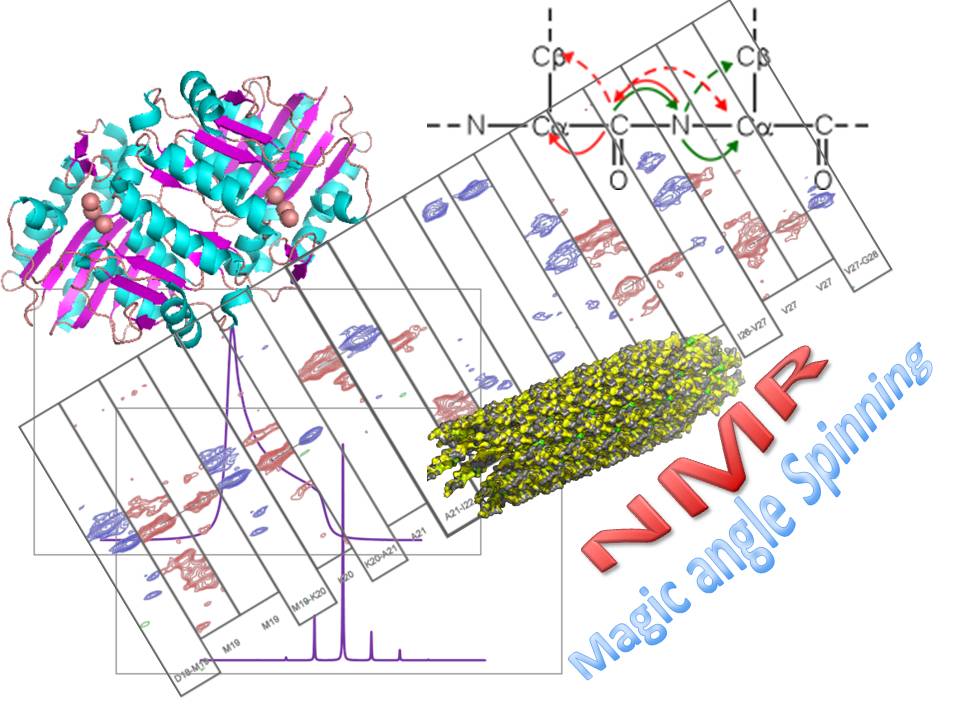
Research
In our group we develop and apply magic-angle spinning NMR techniques to study structure and dynamics in molecules including biological complexes, proteins, viruses, and inorganic materials.Bacteriophages and structural virology:
Bacteriophages comprise a family of bacteria-infecting viruses that share a similar virion structure and life cycle. Have a look here at the fantastic history of phage research! In filamentous bacteriophages, the virion is composed of a circular ssDNA wrapped by thousands of similar copies of a major coat protein and several different minor coat proteins in both ends. Such phages can infect a large variety of bacteria and can be pathogens (e.g., in Vibrio Cholerea).
In our group we prepare, purify and use magic-angle spinning NMR techniques to characterize the structure and dynamics of various phages in various stages of their life cycle in atomic-detailed resolution.
Our group reported the first NMR structure of an intact virus using solid-state NMR. The capsid structure of the M13 virus (pdb: 2MJZ) was solved using MAS NMR data as input to the ROSETTA fold-and-dock protocol.
We solved the structure of another filamentous phage, IKe, which infects E.coli strains bearing N-pili, by cryo electron microscopy. The structure, obtained in collaboration with Ye Xiang from the University of Tsinghua, was deposited in the pdb with code 6A7F.
Our most recent structure is of the complex formed by the hundreds of copies of the protein encoded by gene V, with the 8kb-long native single-stranded DNA (pdb: 8ACZ). This structure is of a premature virus formed within the cells prior to assembly of the intact virus.
Metal sites in enzymes and inorganic materials:
Metal ions play a crucial role in biology and in material science. However, in many cases low occupancies, dynamics and other obstacles hinder the detailed characterization of such sites.
In our group we develop and apply techniques to characterize the structural environment of metal ions such as 11B, 51V, 133Cs, 7Li, 23Na and other similar nuclei having very large, or very small, anisotropic interactions in the magnetic field. We managed to find innovative solutions to determine distances to metal sites that posses a very large anisotropic interaction using phase modulated saturation pulses. Our sequence has further improved and we now employ phase modulated pulses facilitating distance measurements to nuclei with very large quadrupolar coupling constants. Check it out here.
Our most recent projects involve the development and application of 133Cs solid-state NMR technique to study the immobilization of these low-level nuclear waste products for a safer environment. See for example here.
Protein structure by solid-state NMR:
We have interest in understanding and developing means to obtain accurate structures of mid-sized proteins by solid-state NMR, and for that purpose we study microcrystalline proteins.
Lithium spectroscopy and bipolar disorder:
Lithium salts have been known as mood stabilizing drugs for bipolar disorder patients for over 50 years. It was hypothesized that lithium exerts its therapeutic effect by binding to the enzyme myo-inositol monophosphatase (IMPase), thereby reducing inositol levels in the blood and lowering the hyperactive phosphatidyl-inositol cell signaling pathway. Other targets of lithium have also been proposed.
Since lithium is mostly spectroscopically silent, we use magic-angle spinning NMR techniques to directly observe and characterize the lithium binding sites in its drug targets.
In addition, we develop and apply new NMR methods for the characterization of lithium-containing materials.